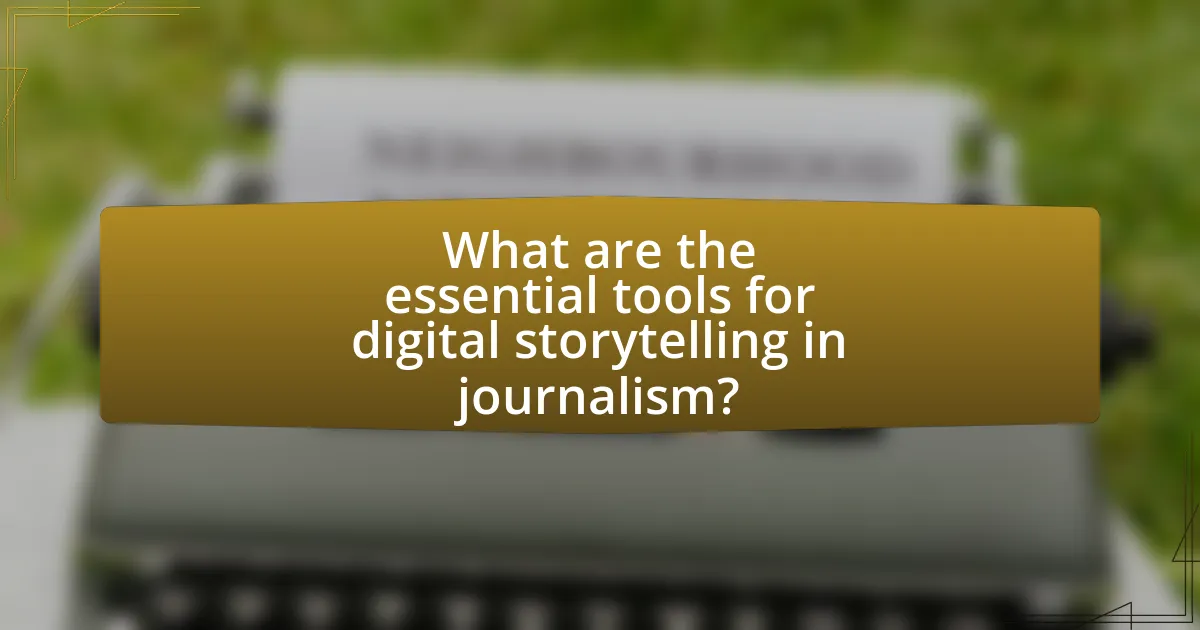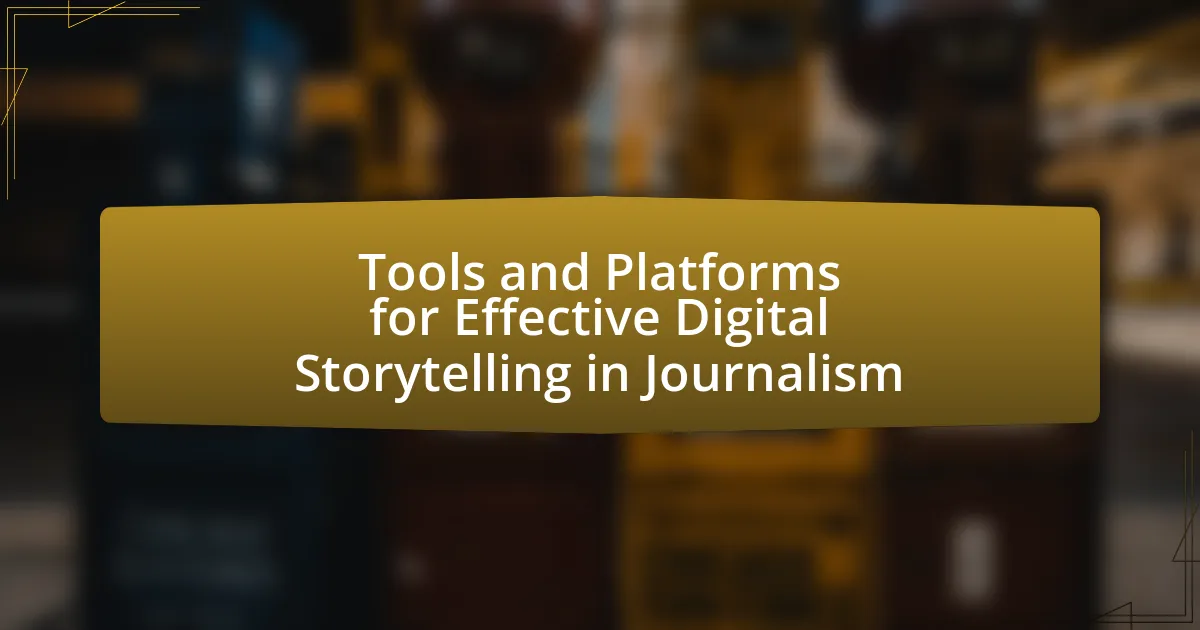The article focuses on the essential tools and platforms for effective digital storytelling in journalism. It outlines key resources such as content management systems, multimedia editing software, social media platforms, and data visualization tools that enhance storytelling capabilities. The discussion includes how these tools improve audience engagement through multimedia integration, interactive elements, and real-time feedback. Additionally, the article addresses common challenges journalists face with these tools and offers strategies for creating compelling narratives and measuring the impact of digital stories.

What are the essential tools for digital storytelling in journalism?
The essential tools for digital storytelling in journalism include content management systems, multimedia editing software, social media platforms, and data visualization tools. Content management systems like WordPress enable journalists to publish and manage their stories efficiently. Multimedia editing software, such as Adobe Premiere Pro and Audacity, allows for the creation and editing of video and audio content, enhancing storytelling through rich media. Social media platforms, including Twitter and Facebook, serve as vital channels for distribution and audience engagement. Data visualization tools like Tableau and Infogram help journalists present complex information in an accessible format, making stories more engaging and informative. These tools collectively enhance the effectiveness of digital storytelling in journalism by improving content creation, distribution, and audience interaction.
How do these tools enhance storytelling capabilities?
These tools enhance storytelling capabilities by providing journalists with advanced features that facilitate creativity, engagement, and interactivity. For instance, multimedia tools allow the integration of text, images, audio, and video, which enriches narratives and captures audience attention more effectively than traditional text alone. Additionally, data visualization tools enable the presentation of complex information in an accessible format, making stories more comprehensible and impactful. Research indicates that stories incorporating multimedia elements can increase audience retention by up to 80%, demonstrating the effectiveness of these tools in enhancing storytelling.
What specific features do these tools offer for journalists?
These tools offer features such as content management systems, multimedia integration, real-time collaboration, data visualization, and audience engagement analytics for journalists. Content management systems enable journalists to organize and publish articles efficiently, while multimedia integration allows for the seamless incorporation of images, videos, and audio into stories. Real-time collaboration features facilitate teamwork among journalists, enabling them to work on stories simultaneously from different locations. Data visualization tools help journalists present complex information in an easily digestible format, enhancing storytelling. Audience engagement analytics provide insights into reader behavior, allowing journalists to tailor their content to better meet audience preferences.
How do these features improve audience engagement?
Features such as interactive elements, multimedia integration, and real-time feedback significantly improve audience engagement in digital storytelling. Interactive elements, like polls and quizzes, encourage active participation, making the audience feel involved and invested in the content. Multimedia integration, including videos and infographics, caters to diverse learning preferences and enhances information retention, as studies show that visuals can increase engagement by up to 94%. Real-time feedback mechanisms, such as comment sections and social media sharing, foster community interaction and allow for immediate audience responses, which can lead to higher levels of engagement and content sharing.
What types of tools are commonly used in digital storytelling?
Commonly used tools in digital storytelling include video editing software, audio editing applications, graphic design platforms, and web-based storytelling tools. Video editing software like Adobe Premiere Pro and Final Cut Pro allows creators to compile and edit video footage effectively. Audio editing applications such as Audacity and Adobe Audition enable the enhancement of sound quality and integration of audio elements. Graphic design platforms like Canva and Adobe Spark facilitate the creation of visually appealing graphics and layouts. Additionally, web-based storytelling tools such as StoryMapJS and Shorthand provide interactive formats for presenting narratives. These tools are essential for enhancing the quality and engagement of digital stories in journalism.
What are the differences between multimedia and text-based tools?
Multimedia tools integrate various forms of content, such as text, images, audio, and video, while text-based tools primarily focus on written content. Multimedia tools enhance engagement and provide a richer storytelling experience by appealing to multiple senses, which can lead to improved retention of information. For instance, studies show that people retain 65% of information when it is presented in a multimedia format compared to only 10% when presented in text alone. In contrast, text-based tools are often simpler and more straightforward, making them easier to produce and edit, but they may lack the emotional impact and engagement levels that multimedia can provide.
How do social media platforms contribute to digital storytelling?
Social media platforms enhance digital storytelling by providing accessible channels for content creation, sharing, and audience engagement. These platforms allow users to create multimedia narratives that combine text, images, and videos, facilitating diverse storytelling methods. For instance, platforms like Instagram and TikTok enable users to share visual stories quickly, reaching vast audiences and fostering community interaction. According to a 2021 Pew Research Center study, 69% of adults in the U.S. use social media, highlighting its role in disseminating stories widely and rapidly. This broad reach amplifies voices that might otherwise go unheard, thus enriching the storytelling landscape in journalism.

What platforms are available for effective digital storytelling?
Platforms available for effective digital storytelling include Medium, Adobe Spark, StoryMapJS, and Canva. Medium allows writers to publish stories with a built-in audience and offers a clean, minimalist design. Adobe Spark provides tools for creating graphics, web pages, and videos, making it versatile for various storytelling formats. StoryMapJS specializes in creating interactive maps that enhance narrative through geographical context, while Canva offers user-friendly design templates for visual storytelling. These platforms are widely used in journalism to engage audiences and present information creatively.
How do these platforms support journalists in their storytelling efforts?
These platforms support journalists in their storytelling efforts by providing tools that enhance content creation, distribution, and audience engagement. For instance, platforms like WordPress and Medium offer user-friendly interfaces for publishing articles, while social media channels such as Twitter and Facebook facilitate real-time audience interaction and feedback. Additionally, analytics tools integrated within these platforms allow journalists to track engagement metrics, helping them refine their storytelling strategies based on audience preferences. This combination of content management, distribution capabilities, and audience insights empowers journalists to craft more impactful narratives.
What are the key functionalities of popular storytelling platforms?
Popular storytelling platforms offer key functionalities such as multimedia integration, interactive elements, and analytics tracking. Multimedia integration allows users to combine text, images, audio, and video to create engaging narratives, enhancing the storytelling experience. Interactive elements, such as polls, quizzes, and clickable maps, enable audience participation, making stories more immersive. Analytics tracking provides insights into audience engagement and behavior, allowing creators to refine their content based on data-driven decisions. These functionalities are essential for effective digital storytelling in journalism, as they enhance user engagement and provide valuable feedback for content improvement.
How do these functionalities cater to different storytelling styles?
The functionalities of digital storytelling tools cater to different storytelling styles by providing diverse formats and interactive elements that enhance narrative engagement. For instance, multimedia capabilities allow journalists to combine text, audio, and video, appealing to visual and auditory learners, while interactive features like polls and quizzes engage audiences actively, making the storytelling experience more immersive. Research shows that stories incorporating multimedia elements can increase audience retention by up to 60%, demonstrating the effectiveness of these functionalities in adapting to various storytelling preferences.
What are the advantages of using specific platforms for storytelling?
Specific platforms for storytelling enhance engagement, accessibility, and interactivity. These platforms, such as social media, blogs, and multimedia tools, allow storytellers to reach diverse audiences effectively. For instance, social media platforms like Instagram and TikTok enable visual storytelling that captures attention quickly, with statistics showing that visual content is 40 times more likely to be shared than other types of content. Additionally, platforms like Medium provide writers with a built-in audience and tools for formatting, which can increase readership and interaction. The use of specific platforms also facilitates real-time feedback and community building, as seen in platforms like Reddit, where users can discuss and share stories instantly.
Which platforms are best suited for visual storytelling?
The best platforms for visual storytelling are Instagram, YouTube, and TikTok. Instagram excels in photo and short video content, allowing users to create visually appealing narratives through posts and Stories, which have over 500 million daily active users. YouTube supports long-form video storytelling, with over 2 billion monthly users, making it ideal for in-depth narratives. TikTok, with its rapid growth and 1 billion monthly active users, focuses on short, engaging videos that encourage creativity and quick storytelling. These platforms provide unique features that enhance visual storytelling, making them effective tools for journalists and content creators.
How do platforms facilitate collaboration among journalists?
Platforms facilitate collaboration among journalists by providing tools that enable real-time communication, content sharing, and project management. These platforms, such as Slack, Trello, and Google Docs, allow journalists to work together seamlessly, regardless of their physical location. For instance, Google Docs enables multiple users to edit documents simultaneously, fostering immediate feedback and collaborative writing. Additionally, platforms like Slack offer channels for specific topics, allowing journalists to discuss ideas and share resources efficiently. Research indicates that effective collaboration tools can enhance productivity by up to 30%, demonstrating their significant impact on journalistic teamwork.

How can journalists effectively utilize tools and platforms for storytelling?
Journalists can effectively utilize tools and platforms for storytelling by leveraging multimedia elements, social media engagement, and data visualization techniques. Multimedia elements, such as videos, podcasts, and infographics, enhance storytelling by providing diverse formats that cater to different audience preferences, thereby increasing engagement. Social media platforms, like Twitter and Facebook, allow journalists to share stories in real-time, interact with audiences, and gather immediate feedback, which can inform future reporting. Data visualization tools, such as Tableau and Infogram, enable journalists to present complex information in an accessible manner, making it easier for audiences to understand key insights. Research indicates that stories incorporating multimedia elements can increase audience retention by up to 80%, demonstrating the effectiveness of these tools in enhancing journalistic storytelling.
What best practices should journalists follow when using these tools?
Journalists should prioritize accuracy, transparency, and ethical considerations when using digital storytelling tools. Accuracy involves fact-checking information and verifying sources to maintain credibility, as evidenced by studies showing that misinformation can significantly undermine public trust in journalism. Transparency requires journalists to disclose their methods and sources, fostering trust with audiences; for instance, the Trust Project emphasizes the importance of transparency in building audience confidence. Ethical considerations include respecting privacy and avoiding sensationalism, which can distort narratives and mislead the public. By adhering to these best practices, journalists can effectively leverage digital tools while upholding the integrity of their work.
How can journalists measure the impact of their digital stories?
Journalists can measure the impact of their digital stories through analytics tools that track engagement metrics such as page views, time spent on the page, shares, and comments. For instance, platforms like Google Analytics provide detailed insights into audience behavior, allowing journalists to assess which stories resonate most with readers. Additionally, social media analytics can reveal how often stories are shared and discussed, indicating their reach and influence. Research shows that stories with higher engagement rates often lead to increased audience trust and loyalty, reinforcing the importance of measuring impact through these quantitative metrics.
What common challenges do journalists face with these tools and platforms?
Journalists commonly face challenges such as information overload, platform fragmentation, and the need for technical skills when using digital storytelling tools and platforms. Information overload occurs as journalists sift through vast amounts of data and sources, making it difficult to identify credible information. Platform fragmentation refers to the variety of tools available, which can lead to inefficiencies as journalists must learn and adapt to multiple systems. Additionally, the requirement for technical skills can be a barrier, as not all journalists are trained in using advanced digital tools, which can hinder their ability to produce high-quality content efficiently. These challenges are supported by studies indicating that 70% of journalists report feeling overwhelmed by the volume of information they encounter, and 60% express concerns about their proficiency with new technologies.
What tips can enhance the effectiveness of digital storytelling?
To enhance the effectiveness of digital storytelling, focus on creating a compelling narrative that engages the audience emotionally. Engaging narratives often incorporate relatable characters, conflict, and resolution, which can significantly increase viewer retention and impact. Research indicates that stories with emotional resonance are 22 times more memorable than facts alone, highlighting the importance of emotional connection in storytelling. Additionally, utilizing multimedia elements such as images, videos, and sound can enrich the storytelling experience, making it more immersive and appealing. Studies show that incorporating visuals can improve information retention by up to 65%, further supporting the effectiveness of a multimedia approach in digital storytelling.
How can journalists create compelling narratives using available tools?
Journalists can create compelling narratives using available tools by leveraging multimedia elements, data visualization, and interactive storytelling platforms. These tools enhance engagement and understanding by allowing journalists to present information in diverse formats, such as videos, infographics, and interactive maps. For instance, platforms like StoryMapJS enable journalists to combine text with geographical data, making stories more immersive. Additionally, data visualization tools like Tableau can transform complex statistics into accessible visuals, aiding in audience comprehension. Research indicates that stories incorporating multimedia elements can increase audience retention by up to 80%, demonstrating the effectiveness of these tools in crafting impactful narratives.
What strategies can improve audience interaction with digital stories?
To improve audience interaction with digital stories, incorporating interactive elements such as polls, quizzes, and comment sections is essential. These features actively engage users, prompting them to participate rather than passively consume content. Research indicates that interactive storytelling can increase user engagement by up to 50%, as it encourages deeper emotional connections and investment in the narrative. Additionally, utilizing social media sharing options allows audiences to disseminate stories within their networks, further enhancing interaction and reach.

Leave a Reply